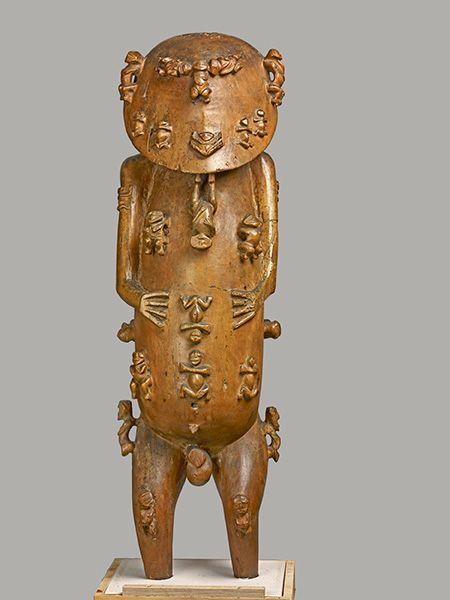The British Museum has lent the world’s most celebrated Oceanic sculpture to Tahiti’s main museum for three years. Known as A’a, the sculpture represents a deified ancestor of the people of Rurutu, a small island nearly 600km south of Tahiti.
Te Fare Iamanaha/Musée de Tahiti et des Iles (Museum of Tahiti and The Islands) was reopened in March after a major expansion. The French architect Pierre-Jean Picart designed a large exhibition hall, where A’a is the star item on display. The museum is located in Punaauia, 10km outside the capital Papeete in French Polynesia.
A’a, carved of sandalwood, stands 1.2m tall. It is a stylised man-like sculpture, but what is most unusual are the 30 small figurines which emerge from its surface. At the back is a cavity which probably once served as a reliquary, holding a human skull.
Until recently A’a was assumed to be from the 18th century, but the latest research shows that the wood dates to 1591-1647, making it among the earliest surviving Polynesian sculptures. The origin of the name A’a, first used by the British missionary John Williams in 1821, remains obscure.
It was in 1821 that some of Rurutu’s chiefs had converted to Christianity, and to demonstrate their allegiance they sent a boat with A’a and other traditional religious objects to the island of Ra’iatea, where the London Missionary Society had a base. At this time Rurutu had only a few hundred inhabitants, since its population had been decimated by the introduction of European diseases.
Williams described the arrival of the boat as laden with “trophies of victory, the gods of heathens taken in this bloodless war [for Christianity]”.
Two centuries on, it is virtually impossible to determine the precise circumstances in which A’a was relinquished or indeed where ownership of it lay. Since it was apparently voluntarily removed from Rurutu by a small group of islanders it was not directly looted by Europeans.
The London Missionary Society took A’a from Ra’iatea to England, where it was displayed in their museum in London. In 1890 the society lent A’a to the British Museum and in 1911 ownership was transferred.
Unfortunately the British Museum has for decades lacked an Oceania gallery, so it does not have an appropriate place to display this key sculpture in a proper context. A’a has therefore been lent to outside exhibitions, such as the Royal Academy of Arts’ 2018 Oceania show.

Henry Moore with a cast of A’a, which was given to him on his 80th birthday by the British Museum Photo: Errol Jackson. Reproduced by permission of the Henry Moore Foundation
A’a has long been a great source of inspiration for European artists. Picasso saw a cast of the sculpture in the home of the English surrealist artist and collector, Roland Penrose, on a visit to Sussex in 1950—and he promptly ordered a copy for his studio. Henry Moore had admired A’a from the 1920s and in 1978 the British Museum presented him with a cast for his 80th birthday. It remains on view in Hoglands, his former home in Hertfordshire.
Along with A’a, the British Museum is lending five other items to Te Fare Iamanaha/Musée de Tahiti et des Iles. The Quai Branly-Jacques Chirac Museum in Paris and Cambridge’s Museum of Archaeology and Anthropology are also lending.
A’a will not be returning to Rurutu, since the remote island of 2,400 inhabitants lacks the facilities of the museum in Tahiti. But another cast is in the town hall on Rurutu.
Steven Hooper, a specialist in Pacific art at the University of East Anglia’s Sainsbury Centre, describes A’a as “one of mankind’s greatest artistic creations, as a thing of great rarity, wonder and curiosity—in the positive 18th-century meaning of that word”.

























